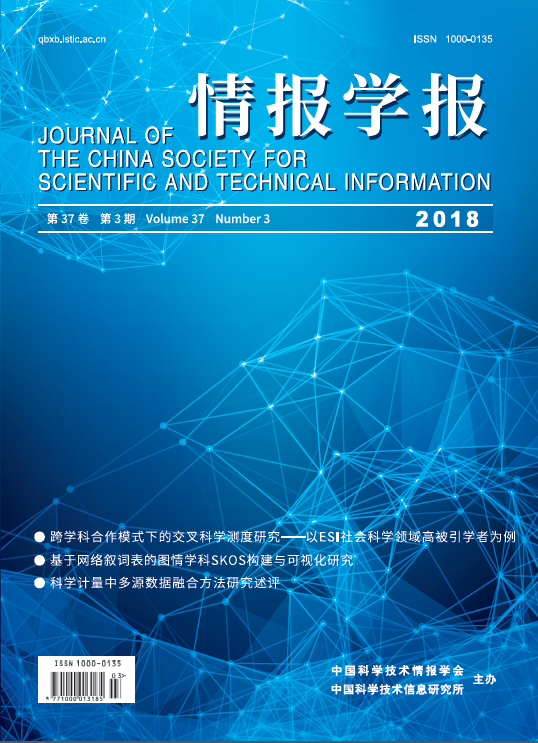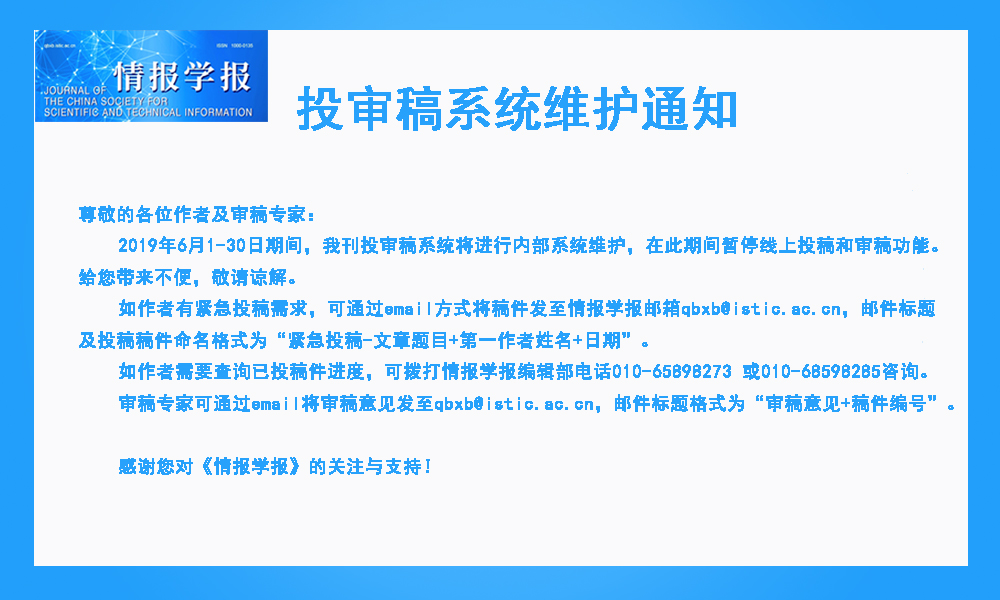 |
|
2018 Vol. 37, No. 3
Published: 2018-03-24 |
|
|
| |
|
|
|
|
|
243 |
Study on Time-dependent Regularity of the Percentage of Never-cited Papers in Journals from Library and Information Science Discipline |
|
 |
Hu Zewen, Wu Yishan, Gao Jiping |
|
|
DOI: 10.3772/j.issn.1000-0135.2018.03.002 |
|
|
The non-citation rate refers to the proportion of articles that do not receive a single citation within a given citation time frame after publication. The current literature on citation distribution focuses on the distribution of articles receiving at least one citation, while the time-dependent distribution of uncited articles is seldom studied. Therefore, a bibliometric analysis of time-dependent distribution of uncited library and information science (LIS) articles published in six journals with different impact factors is executed. We perform an empirical analysis of the time-dependent regularity of the percentages of uncited publications in different citation time-windows (0 to 19 years) following their publication during 1990-1993 period in six selected journals. Furthermore, we also analyze the annual distribution regularity of the percentages of uncited publications following their publication during 1990-2012. Through the above analysis, we found: (1) Time-dependent distribution curve of the percentages of uncited publications (excluding LIS publications) over 20 different citation time windows for five journals can be fitted well using a three-parameter negative exponential model: P(Xt=0)=K+Ae-S*t and the goodness of fit (R2) value for each journal is above 96%; (2) In the initial citation time window, the percentage of never-cited papers in each journal is very high. However, as the citation time window becomes wider, the percentage of never-cited papers (excluding LIS papers) for five journals, begins to drop rapidly at first, and then drops slowly, approaching a very low stably horizontal line after going through an infinitely long citation period. In addition, the total degree of decline for these five journals is very large. Furthermore, the change in the sleep coefficient "S" values for these five journals has the same direction as the change in dropping amplitude values for percentages of uncited publications as the time elapsed. This means that when percentages of uncited publications drop more quickly to a very low stably horizontal line with very few changes, the publications that have not been cited will have a longer sleeping status, until they are woken up or found; (3) Annual distribution regularity of the percentages of uncited publications for six journals reveals that the speed of spread and utilization of publications have increased due to the development of science and technology. As an illustration, annual distribution regularity of the percentages of uncited publications (excluding LIS publications) for five journals have shown a continuous dropping trend, although there is a big annual fluctuation. The percentages of uncited publications for LIS have shown a very high value and very low annual change. |
|
|
2018 Vol. 37 (3): 243-253
[Abstract]
(
222
)
HTML
(1 KB)
PDF
(692 KB)
(
796
) |
|
|
|
254 |
Technological Interactions and Co-opetition Intelligence Based on Patent Citation Networks and Input-Output Analysis among Firms: The Case of Apple Ecosystem |
|
 |
WANG Hailong, WANG Minyu, JIANG Zhaohua |
|
|
DOI: 10.3772/j.issn.1000-0135.2018.03.003 |
|
|
Considering a firm’s citing patents as technology input and its authorized patents as technology output, this paper aims to measure the technological interactions among Apple ecosystems. First, it conceptualizes a theoretical framework including the direct-citation coefficient, co-citation efficient, and coupling coefficient. Then, it estimates the technology influence coefficients and technology sensitivity coefficients. Further, it evaluates the comprehensive technology capabilities of 11 firms in Apple ecosystem, based on the patentee citation networks data from 1998 to 2014. Results show that Intel and AMD are technology leaders in the mobile intelligent terminals industry, Apple has a strong but gradually waning technology influence, and Samsung has a high and rapidly improving technology sensitivity. This method can be applied in other analyses such as industrial technology competence analysis and technology spillover and knowledge flow analysis among firms or regions. |
|
|
2018 Vol. 37 (3): 254-261
[Abstract]
(
374
)
HTML
(1 KB)
PDF
(390 KB)
(
756
) |
|
|
|
262 |
Studies of Competition Patterns and Development Trends in Patents for Global Solar Energy Technology |
|
 |
Chu Zhaopeng, Li Yang, Liu Changxin |
|
|
DOI: 10.3772/j.issn.1000-0135.2018.03.004 |
|
|
Faced with increasingly fierce international competition, climate change, and other global challenges, it is more important for national governments to take on the analysis of the patent intelligence of solar energy technology one step further. Based on the Innography patent information retrieval platform, this study analyzed the competition pattern and development trend in patents for global solar energy technology from the viewpoint of a patent country, application country, IPC distribution, patent rights, and patent strength. The additional analysis focused on the core patent concentration of countries and institutions in the world’s major markets using patent data mining technology. A comparative study was conducted on the technology layout in the Chinese market between local technology developers and global technology developers. It is of great interest to discover the competition trends in patents for global solar energy and the hot technology layout, which this study evaluated in terms of the competitive environment, competitors, competitive technology, and international strategy. In addition, this paper highlighted some key implications, particularly for speeding up technological innovation and industrial upgrades to enhance the international competitiveness of China’s solar energy industry. |
|
|
2018 Vol. 37 (3): 262-273
[Abstract]
(
259
)
HTML
(1 KB)
PDF
(973 KB)
(
1131
) |
|
|
|
274 |
Study of the Construction and Visualization of SKOS in the Library and Information Science Field Based on Online Thesaurus |
|
 |
Shi Zeshun, Xiao Ming |
|
|
DOI: 10.3772/j.issn.1000-0135.2018.03.005 |
|
|
With the rapid development of the semantic Web and linked data, an increasing number of online thesauruses are being annotated by SKOS, which provides a new opportunity for sharing, publishing, and applying of online thesauruses. In this study, we first crawled the library and information science (LIS) online thesaurus of the EBSCO LISTA database and obtained 4255 formal descriptors and 6988 non-descriptors in total. These vocabularies were used to compose the concept data set of the LIS field. Then, SKOS was used to normalize the semantic relations in the LISTA thesaurus; qSKOS was used to verify the completeness of the semantic vocabulary, thus providing a guarantee for the correctness of the SKOS thesaurus; Apache Jena Fuseki was used to publish the LISTA/SKOS thesaurus to the linked data; and the Jena text index was built to support the Lucene free-text search. Finally, we used Graphviz for the drawing and visualization of the LISTA thesaurus network. We also constructed the LIS Thesaurus Retrieval System using Skosmos. In the system, we can browse, query, and retrieve the LIS thesaurus either in English or Chinese. Hence, we reached the conclusion that SKOS can describe the semantic relations between different descriptors. The construction of LISTA/SKOS is of great significance to concept queries, academic knowledge retrieval, and domain ontology construction. |
|
|
2018 Vol. 37 (3): 274-284
[Abstract]
(
324
)
HTML
(1 KB)
PDF
(1972 KB)
(
1099
) |
|
|
|
294 |
Health Information Quality in Social Media: An Analysis Based on the Features of Real and Fake Health Information |
|
 |
Li Yuelin, Zhang Xiu, Wang Shanshan |
|
|
DOI: 10.3772/j.issn.1000-0135.2018.03.007 |
|
|
The study explores the features of real and fake health information to help improve health information quality in social media. The sample includes 482 pieces of information collected from WeChat. The study first identifies real and fake health information through a three-round process involving rumor identification platforms and health experts. Then, the information was imported to NVivo for open coding to identify the features of real and fake information based on a framework that helps to assess information quality. The study conducted Chi-Square tests to identify significant features of fake information, based on which we can develop a feature list of fake health information. The results indicate that gender and occupation affect users’ real and fake information dissemination behavior. Fake information has some salient features that differentiate it from real information in terms of credibility, accuracy, reasonability, and support. In particular, some features, such as punctuation errors, inappropriate use of space, induced text, mismatch between the title and content, strong personal views, redundancy, incomplete content, and under the guise of authority, are typical of fake health information in the Chinese context. The study develops a feature list for fake health information and provides a tool to identify fake health information in social media. It can also help health information systems to develop some mechanism to screen or delete fake information, in order to improve information quality and online health information environment. |
|
|
2018 Vol. 37 (3): 294-304
[Abstract]
(
566
)
HTML
(1 KB)
PDF
(539 KB)
(
5253
) |
|
|
|


